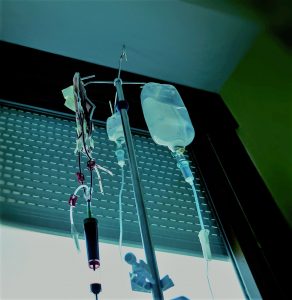Other Treatments
In addition to blood thinners, you may require other interventions, including surgical procedures, implantable devices, or other medications and products. The following are brief summaries of additional interventional options:
Compression Stockings
Doctors sometimes recommend compression stockings (or special elastic socks) for people who have experienced – or are at increased risk of – a blood clot. Compression stockings extend to the calf or groin and help increase blood flow out of the lower extremities and back to the heart. This may help reduce pain and swelling in the legs or arms due to damaged blood vessels, a condition known as post-thrombotic syndrome. Symptoms of post-thrombotic syndrome include chronic swelling, aching, heaviness and cramping in the legs or arms.
When wearing compression stockings, the greatest pressure should be exerted at the ankle without excessive tightness behind the knee. Pressure of 30-40 mmHg is most effective, You should speak with your doctor about which length – knee or thigh-high – is best for you.
Compression stockings can be obtained through a doctor’s prescription, from a medical supply store, over-the-counter at major drugstores, or online. Before purchasing, it is important to be professionally measured to ensure proper fit. Some major insurance companies cover the cost of compression stockings so it is important to coordinate with your provider before buying them.
Thrombolytic Therapy
 Some patients who have massive blood clots, or disease that progresses despite anticoagulant treatment, may require clot-dissolving drugs or surgeries to remove blockage. These are aggressive options, but can help to save the lives, limbs and organs of individuals with extensive and/or complicated clots. Likewise, they can be valuable approaches for relieving debilitating symptoms that persist after blood thinner use and may prevent post-thrombotic syndrome (PTS), a condition in which limb pain, swelling and other symptoms become chronic and long-term problems.
Some patients who have massive blood clots, or disease that progresses despite anticoagulant treatment, may require clot-dissolving drugs or surgeries to remove blockage. These are aggressive options, but can help to save the lives, limbs and organs of individuals with extensive and/or complicated clots. Likewise, they can be valuable approaches for relieving debilitating symptoms that persist after blood thinner use and may prevent post-thrombotic syndrome (PTS), a condition in which limb pain, swelling and other symptoms become chronic and long-term problems.
Thrombolytic drug therapy involves the use of fibrinolytic agents that break up fibrin, a core component of clots. These medications are normally infused into the clot through intravenous catheters. Bleeding risks are a serious concern with these agents, so patients must be thoroughly evaluated for bleeding potential before undergoing this course of treatment.
In some instances, surgery is warranted to physically remove the clot from the affected vein. Surgeries are most common with pulmonary embolism (PE or blood clots in the lungs) and a procedure known as pulmonary thromboembolectomy. Again, patients need to be carefully screened to minimize bleeding risk and ensure that surgical benefits outweigh the risk of complications.
Mechanical Thrombectomy
Mechanical thrombectomy – a minimally invasive procedure that involves the removal of blood clots – is commonly used for the treatment of stroke, or the removal of clots in the arterial system, and it has contributed to an important reduction in stroke-related disability and death.
More recently, with some high-risk cases of pulmonary embolism, advanced therapies like mechanical thrombectomy may be used in addition to anticoagulation. The introduction of venous designed mechanical thrombectomy devices, developed specifically for the removal of dangerous blood clots in the veins, are a nonsurgical treatment option for high-risk deep vein thrombosis (DVT) and pulmonary embolism (PE) that do not involve the use of thrombolytic or clot-dissolving therapies.
This non-surgical, non-thrombolytic treatment option for DVT/PE is performed by an interventional cardiologist, interventional radiologist, or a vascular surgeon, and involves the use of continuous X-ray imaging to guide catheters placed inside a vein to reach and remove dangerous blood clots. Once the clot is removed, blood flow is restored immediately and may result in a shorter hospital stay for people who undergo this procedure. Whether mechanical thrombectomy is better than other treatments, including anticoagulation alone, is unknown and clinical trials are currently underway.
Vena Cava Filters

To reduce the risk of a blood clot in the arms or legs migrating to the lungs and forming a pulmonary embolism (PE or blood clot in the lung), a cone-shaped filter is sometimes surgically implanted in the inferior vena cava, a large vein in the abdomen that brings blood from the lower body back to the heart.
These devices are reserved for patients at high risk of PE who cannot be treated with blood thinning medications. Newer designs have made these filters retrievable, so they can be removed once the patient can take anticoagulants.
While each individual is different and treatment options can vary greatly from person to person, it is important to have regular and ongoing care from a committed and consistent medical team throughout your blood clot experience. Treatment of a blood clot is complex and benefits greatly from the knowledge and experience of a variety of specialists working in coordination with your primary-care doctor. Click here if you need help finding a qualified physician near you.
What’s Next:
- Return to NBCA’s Blood Clot Treatment Page for more information
- Get help finding a specialist near you





